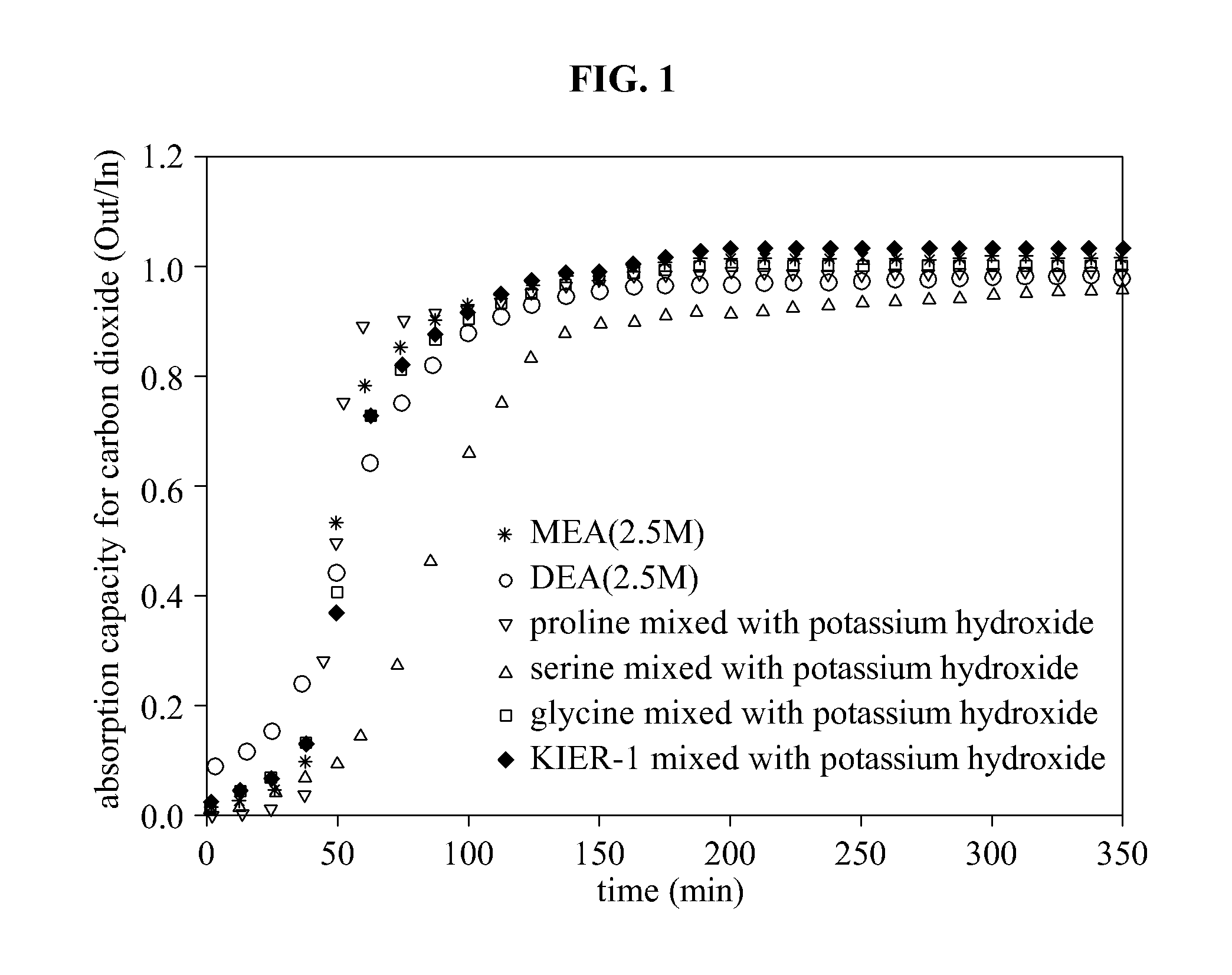Absorbent for capturing cardon dioxide including amino acid having multi amine groups and metal hydroxide
a technology of amino acids and metal hydroxides, which is applied in the direction of dispersed particle separation, other chemical processes, and separation processes, etc., can solve the problems of affecting the absorption efficiency of carbon dioxide, and consuming the highest amount of energy for mea regeneration, etc., to achieve the effect of reducing the heat absorption reaction, and increasing the absorption capacity of carbon dioxid
- Summary
- Abstract
- Description
- Claims
- Application Information
AI Technical Summary
Benefits of technology
Problems solved by technology
Method used
Image
Examples
example 1
Absorption Capacity for Carbon Dioxide and Absorption Reaction Energy of Absorbent Using Amino Acid and Metal Hydroxide
[0055]KIER-1 is an absorbent used in Example 1, and is an absorbent where potassium hydroxide and lysine among amino acids having multiple amine groups are mixed in an equivalent ratio of 1:1. The amino acid used in Example 1 has multiple amine groups, and a molecular weight of the amino acid is about 130 g / mol to about 150 g / mol. When the amino acid is mixed with water solution, a zwitterion is generated. Absorption reaction does not occur between the amino acid with the zwitterion and carbon dioxide. When an alkali-metal hydroxide including potassium, lithium, or sodium is mixed with the amino acid, a state of the zwitterion is changed and thus, the absorption capacity for carbon dioxide may significantly increase. According to a result of Example 1, the absorption capacity for carbon dioxide may be increasingly high in an order of sodium hydroxide, lithium hydrox...
example 2
Carbon Dioxide Absorption Rate of Absorbent Using Amino Acids and Metal Hydroxide
[0062]A high carbon dioxide absorption rate and a high absorption capacity for carbon dioxide may be used for an economical absorption process that absorbs carbon dioxide. Even though an absorption capacity of a tertiary amine is 2 times greater than MEA classified as a primary amine, it is difficult to use the tertiary amine due to a low absorption rate. Example 2 evaluates the absorption rate based on a wetted wall column that accurately evaluates an absorption rate, using all absorbents mentioned in Example 1.
[0063]According to an overall mass transfer coefficient (KG), a carbon dioxide absorption rate of KIER-1 that is the same absorbent used in Example 1 showed 2.02 E-10 mol / cm2·sec·Pa that is 2 times faster than 1.11 E-10 mol / cm2·sec·Pa of MEA. Also, the carbon dioxide absorption rate of KIER-1 is lower than proline and is higher than serine and glysine.
TABLE 2Overall mass transfer coefficient of ...
PUM
| Property | Measurement | Unit |
|---|---|---|
| molecular weight | aaaaa | aaaaa |
| pressure | aaaaa | aaaaa |
| concentration | aaaaa | aaaaa |
Abstract
Description
Claims
Application Information
 Login to View More
Login to View More - R&D
- Intellectual Property
- Life Sciences
- Materials
- Tech Scout
- Unparalleled Data Quality
- Higher Quality Content
- 60% Fewer Hallucinations
Browse by: Latest US Patents, China's latest patents, Technical Efficacy Thesaurus, Application Domain, Technology Topic, Popular Technical Reports.
© 2025 PatSnap. All rights reserved.Legal|Privacy policy|Modern Slavery Act Transparency Statement|Sitemap|About US| Contact US: help@patsnap.com


